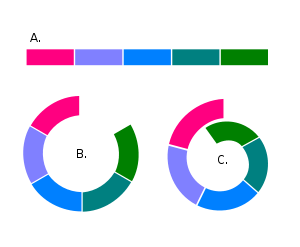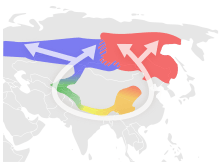Ring species

In biology, a ring species is a connected series of neighbouring populations, each of which can interbreed with closely sited related populations, but for which there exist at least two "end" populations in the series, which are too distantly related to interbreed, though there is a potential gene flow between each "linked" population. Such non-breeding, though genetically connected, "end" populations may co-exist in the same region thus closing a "ring". The German term Rassenkreis, meaning a ring of populations, is also used.
Ring species provide important evidence of evolution in that they illustrate what happens over time as populations genetically diverge, and are special because they represent in living populations what normally happens over time between long deceased ancestor populations and living populations, in which the intermediates have become extinct. Richard Dawkins observes that ring species "are only showing us in the spatial dimension something that must always happen in the time dimension".[1]
Formally, the issue is that interfertility (ability to interbreed) is not a transitive relation – if A can breed with B, and B can breed with C, it does not follow that A can breed with C – and thus does not define an equivalence relation. A ring species is a species that exhibits a counterexample to transitivity.[2]
Problem of definition
Ring species also present an interesting case of the species problem for those seeking to divide the living world into discrete species. All that distinguishes a ring species from two separate species is the existence of the connecting populations; if enough of the connecting populations within the ring perish to sever the breeding connection then the ring species' distal populations will be recognized as two distinct species.
The problem is whether to quantify the whole ring as a single species (despite the fact that not all individuals can interbreed) or to classify each population as a distinct species (despite the fact that it can interbreed with its near neighbours). Ring species illustrate that the species concept is not as clear-cut as it is often thought to be.
Known examples
History
Currently, there are four known forms of life that appear to match the definition of a ring species. The classic example is that of the Larus gull, which in 1925 was found to form a chain of varieties around the Arctic Circle by Jonathan Dwight, but lately doubts have arisen as to whether this is an actual ring species.[3] In 1938, Claud Buchanan Ticehurst hypothesized the greenish warbler spread from Nepal around the Tibetan Plateau, while adapting to each new environment, meeting again in Siberia where the ends no longer interbreed.[4] These and other discoveries led Ernst Mayr to first formulate a theory on ring species in his 1942 study Systematics and the Origin of Species. Also in the 1940s, Robert C. Stebbins recognised the Ensatina around the Californian Central Valley as a ring species;[5][6] however, some authors consider this classification as incorrect.[7] Finally in 2012, the first example of a ring species in plants was found in a spurge form around the Caribbean Sea.[8]
Larus gulls


A classic example of ring species was the Larus gulls' circumpolar species "ring". The range of these gulls forms a ring around the North Pole, which is not normally transited by individual gulls.
The European herring gull (L. argentatus argenteus), which lives primarily in Great Britain and Ireland, can hybridize with the American herring gull (L. smithsonianus), (living in North America), which can also hybridize with the Vega or East Siberian herring gull (L. vegae), the western subspecies of which, Birula's gull (L. vegae birulai), can hybridize with Heuglin's gull (L. heuglini), which in turn can hybridize with the Siberian lesser black-backed gull (L. fuscus). All four of these live across the north of Siberia. The last is the eastern representative of the lesser black-backed gulls back in north-western Europe, including Great Britain.
The lesser black-backed gulls and herring gulls are sufficiently different that they do not normally hybridize; thus the group of gulls forms a continuum except where the two lineages meet in Europe.
However, a 2004 genetic study has shown that this example is far more complicated than presented here (Liebers et al., 2004):[9] this example only speaks to the complex of species from the classical herring gull through lesser black-backed gull. There are several other taxonomically unclear examples that belong in the same species complex, such as yellow-legged gull (L. michahellis), glaucous gull (L. hyperboreus), and Caspian gull (L. cachinnans).
Greenish warbler

The greenish warbler (Phylloscopus trochiloides) forms a species ring, around the Himalayas.[10] It is supposed to have spread from Nepal around the inhospitable Tibetan Plateau, to rejoin in Siberia, where the plumbeitarsus and the viridanus appeared to no longer mutually procreate.
Song sparrow
The song sparrow (Melospiza melodia) forms a ring around the Sierra Nevada of California[11] with the subspecies heermanni and fallax meeting in the vicinity of the San Gorgonio Pass.
Euphorbia tithymaloides
Euphorbia tithymaloides is a group within the spurge family that has reproduced and evolved in a ring through Central America and the Caribbean, meeting in the Virgin Islands where they appear to be morphologically and ecologically distinct.[8]
See also
- Cline (biology)
- Species complex
- Species problem
- Speciation
- Parapatric speciation
- Dialect continuum, a similar concept in linguistics
- Cryptic species
- Sorites paradox
- Intergradation
References
- ↑ Dawkins, R. The Ancestor's Tale, 2004:303
- ↑ Brown, Rob. ""Same Species" vs. "Interfertile": concise wording can avoid confusion when discussing evolution""
- ↑ Liebers, D.; De Knijff, P.; Helbig, A. J. (2004). "The herring gull complex is not a ring species". Proceedings of the Royal Society B: Biological Sciences. 271 (1542): 893–901. doi:10.1098/rspb.2004.2679. PMC 1691675
 . PMID 15255043.
. PMID 15255043. - ↑ The greenish warbler ring species, by Darren Irwin
- ↑ A closer look at a classic ring species: The work of Tom Devitt
- ↑ This species ring forms the subject of "The Salamander's tale" in Richard Dawkins' The Ancestor's Tale, 2004.
- ↑ "The problem, as David Wake now admits, is that these salamanders never comprised a continuous 'ring,' but were separated geographically on and off over millions of years, so it’s entirely possible that the reproductive isolation did not occur through the gradual attenuation of gene flow with distance." — Jerry Coyne, Why Evolution Is True, retrieved 2014-01-10; citing Speciation; Coyne, J., and Orr, A., c2004 ISBN 0878930914
- 1 2 Cacho & Baum (2012) "The Caribbean slipper spurge Euphorbia tithymaloides: the first example of a ring species in plants", Proceedings of the Royal Society B
- ↑ Liebers, Dorit; de Knijff, Peter; Helbig, Andreas J. (2004). "The herring gull complex is not a ring species" (PDF). Proceedings of the Royal Society B. 271 (1542): 893–901. doi:10.1098/rspb.2004.2679. PMC 1691675
 . PMID 15255043. Electronic Appendix
. PMID 15255043. Electronic Appendix - ↑ Alström, Per (2006). "Species concepts and their application: insights from the genera Seicercus and Phylloscopus" (PDF). Acta Zoologica Sinica. 52 (Suppl): 429–434.
- ↑ Patten and Pruett, Per (2009). "The Song Sparrow, Melospiza melodia, as a ring species: patterns of geographic variation, a revision of subspecies, and implications for speciation" (PDF). Systematics and Biodiversity. 7 (1): 33–62. doi:10.1017/s1477200008002867.
- Irwin DE, Irwin JH, Price TD (2001). "Ring species as bridges between microevolution and speciation" (PDF). Genetica. 112-113: 223–43. doi:10.1023/A:1013319217703. PMID 11838767.
- Futuyma, D. (1998). Evolutionary Biology (3rd ed.). Sunderland, MA: Sinauer Associates. ISBN 0-87893-188-0.
- Moritz, C., Schneider, C.J.; et al. (1992). "Evolutionary relationships within the Ensatina eschscholtzii complex confirm the ring species interpretation". Systematic Biology. 41: 273–291. doi:10.2307/2992567.
- Nova Scotia Museum of Natural History: Birds of Nova Scotia
- Adriaens, P. Hybrid Gulls Breeding in Belgium
External links
- Greenish Warbler
- Greenish Warbler maps and songs
- Ensatina salamander
- Ring species -- the abridged version, by Peter Hadfield alias potholer54